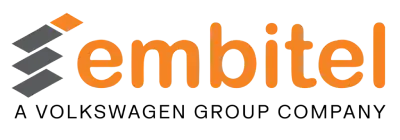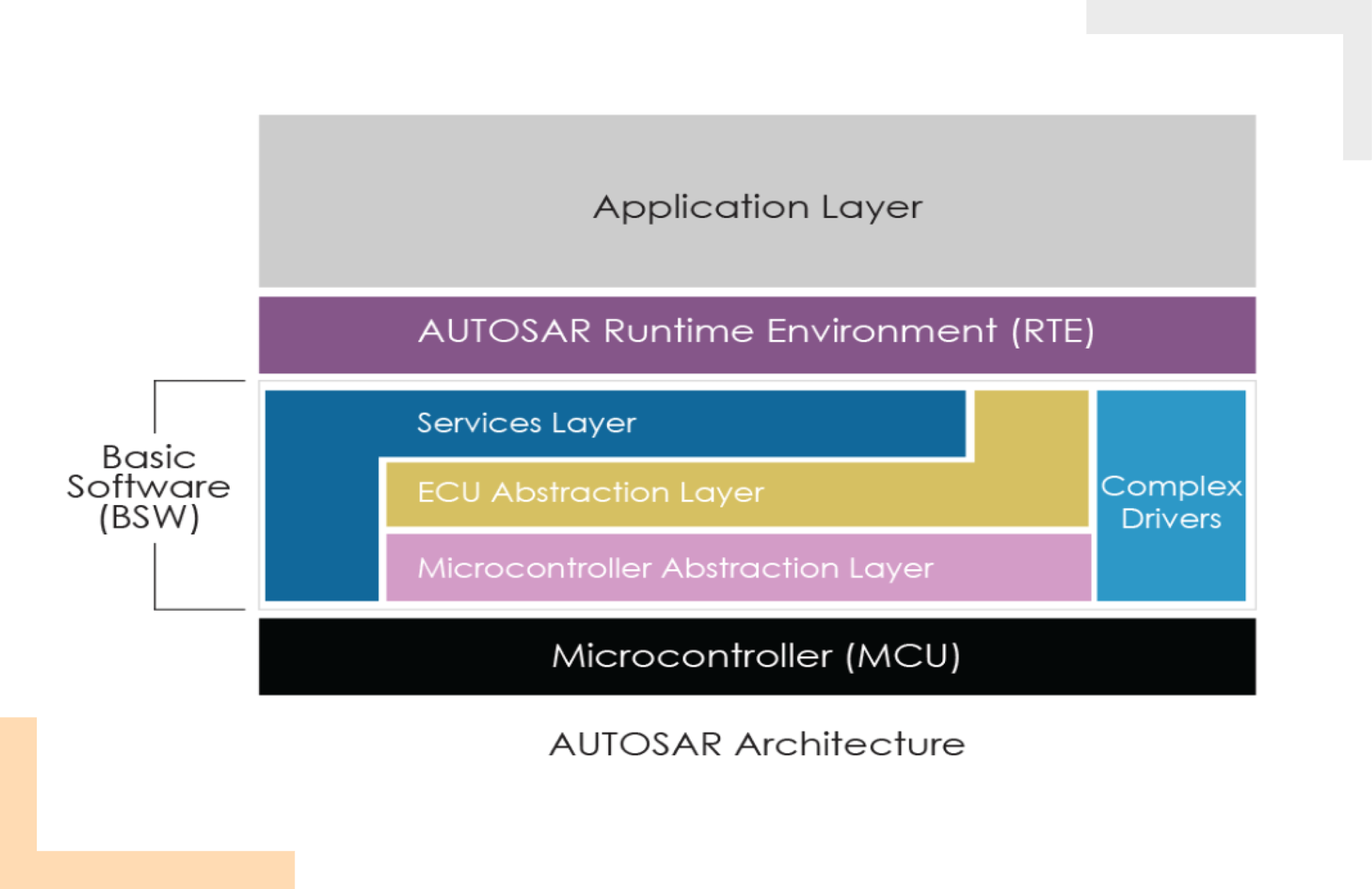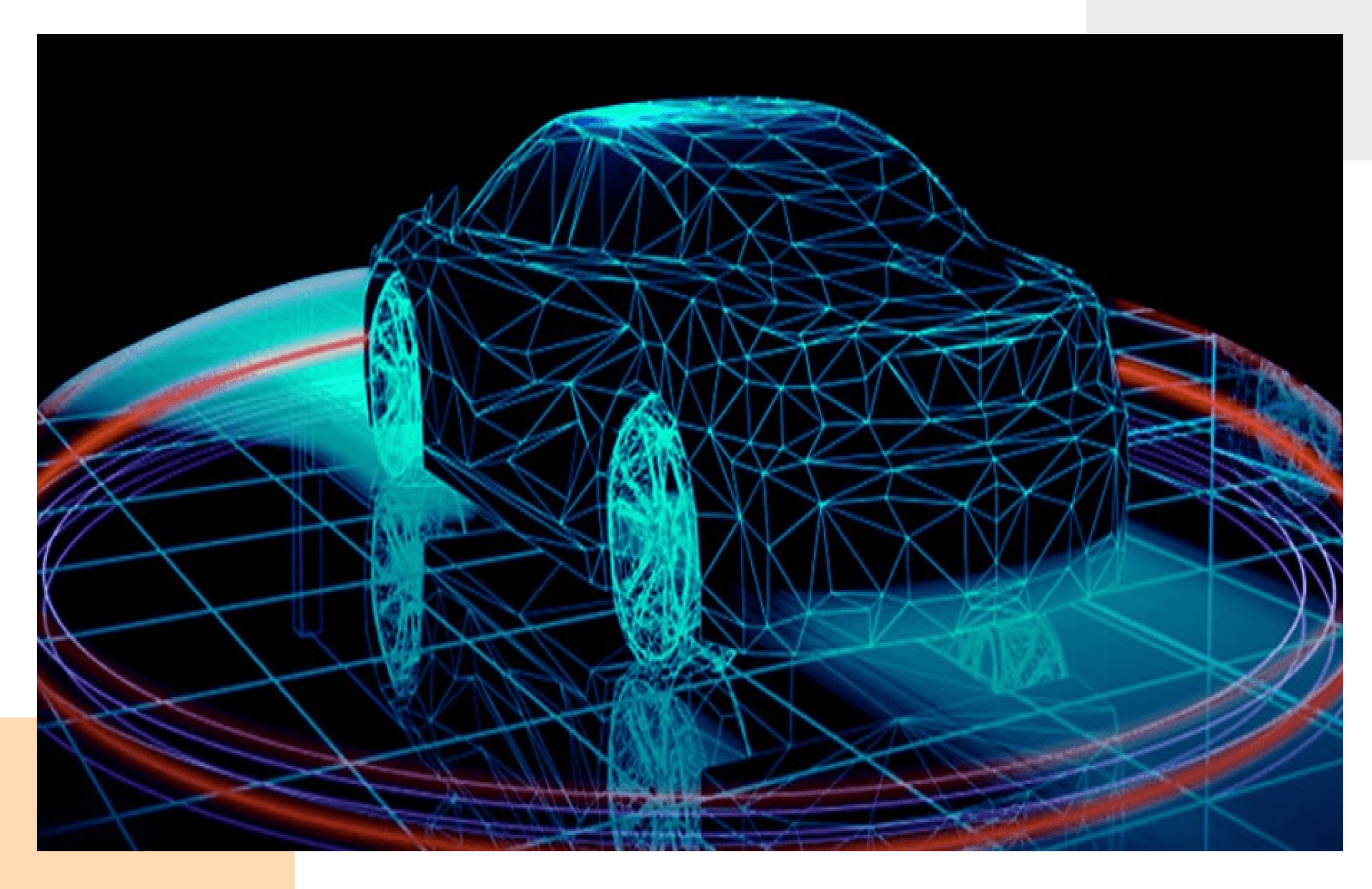Adopting AUTOSAR (Automotive Open System Architecture) resolves a number of key issues in automotive software development. AUTOSAR is able to do so by introducing standardization and modularity.
As automotive systems become more complex with increasing functionality, managing this complexity efficiently is crucial. AUTOSAR architecture provides a standardized platform that organizes and simplifies the development process.
With components sourced from various suppliers, ensuring compatibility and interoperability is a challenge. AUTOSAR defines a common set of standards that all components must adhere to, ensuring that they can work seamlessly together.
And most importantly, AUTOSAR architecture supports the implementation of safety-critical applications according to industry standards like ISO 26262. It provides mechanisms for error handling and functional safety that are essential in modern vehicles.
One solution for a lot of problems!
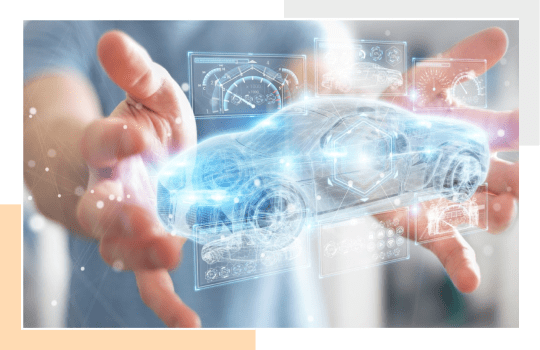
AUTOSAR has a complex relation with standards such as ASPICE and ISO 26262.
At Embitel, we take this complexity out of the process to help you develop AUTOSAR compliant automotive software.
Our AUTOSAR expertise includes BSW (Basic Software) configuration, MCAL (Microcontroller Abstraction Layer) development, RTE authoring, Application development and specialized CDD (Complex Device Driver) creation.
AUTOSAR Success Stories
A Handbook on AUTOSAR & ISO26262 Compliant MCAL
Learn about AUTOSAR Architecture of MCAL, Configuration & Code Generation Tools, MCAL Driver Development and Testing
Download PDF
AUTOSAR Software Development Services
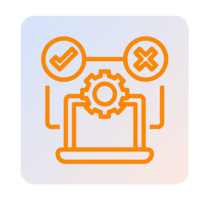
AUTOSAR MCAL Development
- Custom MCAL development for automotive grade MCU platforms
- MCAL configuration, porting, and integration services for intended functionality of on-board MCU peripherals
- Rigorous verification and validation of MCAL for robust performance
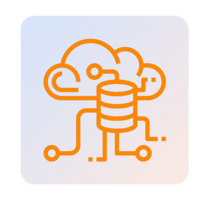
AUTOSAR Migration Support
- Gap analysis and strategy development.
- Design, develop, and integrate AUTOSAR-compliant software components.
- Support for both standard and complex device drivers.
- Configuration of the Runtime Environment (RTE) according to the specific needs of the project.
- Comprehensive testing services, including unit testing, integration testing, and system testing post migration.
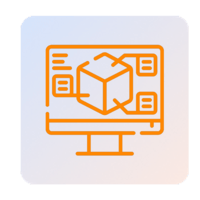
Complex Device Driver Development
- Design and implementation of custom CDD modules tailored to unique hardware.
- Support for interface development for CDD and AUTOSAR RTE and MCAL.
- Integration and testing of complex device drivers.
- Implementation of comprehensive diagnostic routines and error handling mechanisms within the CDD.
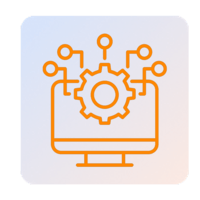
AUTOSAT RTE Layer Integration and Testing
- Automated generation of RTE from System Description (ARXML files) using standard tools like DaVinci Developer, EB tresos, etc.
- Custom RTE configurations based on the specific needs of the project.
- RTE and Basic Software Scheduler Implementation.
- Development and integration of communication paradigms.
- Implementation of modes handling for smooth operational state transition.
- External and internal trigger configurations.
- Variant and development error handling.
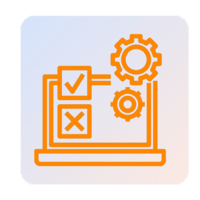
Application Development
- Model-based development (MATLAB Simulink, DaVinci Developer, etc.).
- Control algorithm development with C programming.
- Legacy code to model conversion or AUTOSAR conversion./li>
- Interface with the RTE layer.
- Integration with BSW libraries.
- Specific SW-C development, testing, and Integration with complete software.

AUTOSAR BSW Configuration and Integration
- Development, configuration, and integration of Base Software (BSW).
- Integration of BSW with application component
- Configuration of BSW layer with AUTOSAR tools like ETAS, Vector
- Operating system configuration for single-core and multi-core processors.
- AUTOSAR Bootloader Configuration
- Communication, Diagnostic Stack and NVM Configuration
Features of our AUTOSAR services
Model-Based Development (MBD)
Use of MBD expertise and tools for design and development to be carried out using high-level graphical models rather than traditional manual coding.
Tool Chain Expertise
Proficiency in popular AUTOSAR development tools like ARCCORE, DaVinci Developer, EB tresos, and Vector tools.
ISO 26262 Compliance
We are proficient in ISO 26262 standard and methodologies to implement Functional Safety in AUTOSAR.
ASPICE Expertise
Understanding and expertise in ASPICE process framework, which assists in the development of AUTOSAR compliant automotive software systems.
Migration Support
We assist customers in transitioning smoothly to AUTOSAR from non-AUTOSAR systems.
Testing and Validation
Validation is the key to high-quality software. We offer hardware-in-loop (HIL) and Software-in-loop (SIL) tests using HIL test setup, Vector CANoe and other tools.

AUTOSAR Use-cases
AUTOSAR use-cases vary significantly between automotive OEMS and Tier-1 suppliers due to their different roles and responsibilities in the automotive ecosystem. Here’s how our AUTOSAR services are tailored to cover the automotive ecosystem.
| AUTOSAR for OEMs | AUTOSAR for Tier-1s | AUTOSAR for Semiconductor Companies |
|---|---|---|
| Standardized Software Architecture: It facilitates the integration of diverse electronic control units (ECUs) from multiple suppliers. | Software Development: Tier-1s develop automotive solutions such as infotainment system, brake ECUs, ADAS etc. They require expertise to build such software. | MCAL Development and Integration: Development and integration of standardized drivers for peripherals (e.g., ADC, CAN, DIO, PWM, SPI). |
|
Custom Software Development: OEMs often require custom extensions to the AUTOSAR standard to meet specific system designs or unique functionalities. This includes custom device drivers, advanced network management, and bespoke cybersecurity measures. |
Compliance and Standard: Compliance to standards such as ISO 26262 and ISO 21434 is crucial for Tier-1s if it is their customer’s requirements. | Complex Device Driver (CDD) Development: Development of specialized software module designed to handle functionalities that are not covered by standard AUTOSAR modules. |
| FOTA enablement: FOTA update feature improves vehicle functionality and security over its lifecycle. | Migration to AUTOSAR: Tier-1s often find themselves grappling with this requirement where legacy software needs to be migrated to AUTOSAR architecture. | BSW Configuration and Code Generation: Configuration and generation of code for Basic Software modules like communication, memory, diagnostics. |
| ISO 26262 Functional Safety: AUTOSAR helps OEMs build safety-critical automotive solutions. The standard provides standardized approaches to managing safety-critical systems, such as braking and steering controls. | Driver Development: Development of complex device drivers, base software and MCAL drivers is one of the most common use-cases that Tier-1s cater to. | Application Software Development: Development of application-specific software components. |
Understanding AUTOSAR Layered Architecture
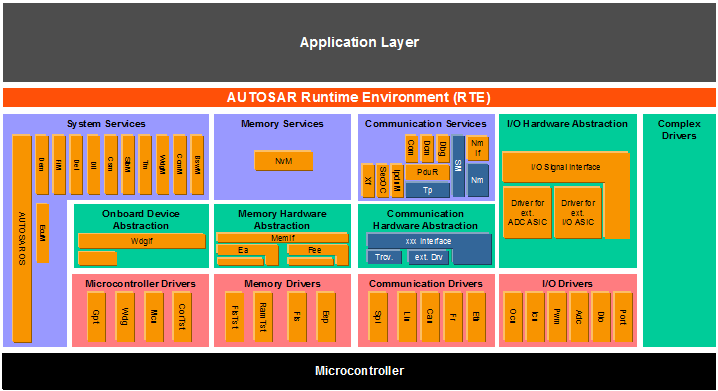
AUTOSAR Architecture
Customer FAQs About AUTOSAR MCAL, BSW, RTE and AUTOSAR Testing Services
Ans. Our AUTOSAR Software developers have in-depth expertise and project experience in AUTOSAR MCAL driver development.
We have partnered with automotive leaders for the development of microcontroller drivers such as PT driver and MCU driver; Communication drivers like CAN, LIN, FlexRay and MOST and I/O drivers like ICU, PWM, ADC, Flash, and EEPROM.
Our AUTOSAR software development team has partnered with customers for the development of static file of the microcontroller driver and the AUTOSAR MCAL driver configuration.
Ans. Embitel provides product engineering services for AUTOSAR BSW layer development. It includes configuration of memory stack (MemStack), AUTOSAR communication stack (COMStack like CAN, LIN, FlexRay) and DCM (Diagnostic Communication Manager).
The configuration of the Operating System is also a part of the AUTOSAR BSW layer development.
Ans. It is a non-AUTOSAR component which has access to the services of the AUTOSAR MCAL and also has an interface with the AUTOSAR compliant Application Layer.
A CDD is designed to access the AUTOSAR application layer and AUTOSAR MCAL layer without having to communicate via the BSW and RTE Layers.
It is commonly used to integrate additional hardware components to AUTOSAR compliant Electronic Control Units (ECU).
Ans. We provide support in development of ISO 26262 Functional safety compliant CDD.
We support in validating the CDD by creating Test environment which includes Test Application, MCAL Drivers and AUTOSAR OS.
In case of non-availability of MCAL Drivers or OS; we can support in CDD validation by
- Creation of stubs that replicate MCAL Driver
- Deploying a Simple Scheduler to replicate AUTOSAR OS.
We also provide support in integration of CDD with existing configuration.
Ans. Yes, we provide support for configuration of diagnostic messages according to the project requirements.
The configuration sequence details are discussed in detail during the AUTOSAR Technology Workshops as part of our SLA.
Ans. Yes, we provide support for the configuration of the interface layer as per your project/application requirement.
Ans. Yes, our AUTOSAR software developers have expertise in the configuration of the AUTOSAR RTE (Real Time Environment), that serves as an interface between the application software module (SWC) and the AUTOSAR BSW.
Ans. Yes, our AUTOSAR software development team has delivered projects on the latest versions of AUTOSAR ( from AUTOSAR 4.0 to AUTOSAR 4.3).
We have also worked on projects based on earlier versions of AUTOSAR software.
Ans. Yes. Our AUTOSAR software development team has successfully partnered with global OEMs’ and Suppliers for migration to AUTOSAR 4.3.
We can share the success stories of our customers after signing the NDA agreement.
Ans. We have delivered projects on configuration and code generation based on AUTOSAR tools like Comasso, Vector, ECU Spectrum, KSAR AUTOSAR.
We also have experience in working with design tool DaVinci Developer and scripting tools based on Pearl and Python.
Ans. As part of our AUTOSAR Testing suite, following testing services are included:
- Module Testing,- individual AUTOSAR modules are tested for various test-case scenarios. This is White Box testing.
- Integration test – after integration of individual AUTOSAR modules, we perform integration testing based on relevant test-case scenarios. This is also a White Box Testing.
- System level testing (end application layer testing). – This is Black Box testing where we test the entire product/embedded system.
Write to us to know more detailed information about our testing services.
Ans. Yes. The application development can be done based on the specification of the project. We have expertise in both manual coding and tool-based code generation.
Our team of software development engineers has extensive experience in manual coding implemented in Embedded C.
We also have expertise and experience in working with the code generation tools like Matlab, Vector, Comasso and much more.
Ans. The AUTOSAR development process includes several phases:
- System Design –Defining the architecture and communication
- ECU Development – Implementing and configuring SWCs, BSW, and RTE
- Software Component Development – Independently developing SWCs
- Integration – Combining and testing SWCs
- Verification and Validation – Extensive testing to ensure compliance and functionality
Ans. AUTOSAR compliance refers to adhering to the standards and guidelines set by the AUTOSAR (AUTomotive Open System ARchitecture) consortium.
This compliance ensures that automotive software components are developed in a standardized manner, which improves interoperability, safety, and reliability across various electronic control units (ECUs) in vehicles.
A Handbook on AUTOSAR BSW & RTE
Learn about AUTOSAR Architecture and Configuration process of the Base Software (BSW) & Real-Time Environment (RTE)
Download PDF
Blogs on AUTOSAR Architecture: Learn about AUTOSAR MCAL, AUTOSAR Communication Stack and more
- What is AUTOSAR MCAL? Learn about the software module architecture and device drivers
- What is AUTOSAR Communication Stack (ComStack)? Introduction to CAN Communication Stack
- What is AUTOSAR Memory Stack | Software modules and device drivers
- What is AUTOSAR development partnership and AUTOSAR MCAL Layer
- Decoding the “Component Concept” of the Application Layer in AUTOSAR
- Decoding the Implementation of UDS Vehicle Diagnostics in AUTOSAR Base Software Module
- Adaptive AUTOSAR vs Classic AUTOSAR: Which Way is the Automotive Industry Leaning?
- How to Leverage Model Based Development for Delivering AUTOSAR Software Components?
Knowledge bytes
What is AUTOSAR MCAL?
AUTOSAR MCAL is a software module that directly accesses on-chip MCU peripheral modules and external devices that are mapped to memory, and makes the upper software layer independent of the MCU. (Source – Renesas)
What is AUTOSAR layered architecture?
AUTOSAR uses a three-layered architecture:
- Basic Software (AUTOSAR BSW): Basic Software is the standardized software layer, which provides services to the AUTOSAR Software Components and is necessary to run the functional part of the software. It does not fulfill any functional job itself and is situated below the AUTOSAR RTE (Runtime Environment). The Basic Software contains standardized and ECU specific modules.
- Runtime environment (AUTOSAR RTE): Middleware which abstracts from the network topology for the inter- and intra-ECU information exchange between the application software components and between the Basic Software (BSW) and the applications.
- Application Layer: application software components that interact with the runtime environment (RTE).
Source – AUTOSAR.org
Why migrate to AUTOSAR architecture from legacy software?
AUTOSAR layered architecture ensures a clear demarcation between the application software and hardware platform and drivers with the help of RTE. This facilitates a shift in ECU design approach from coding to configuration
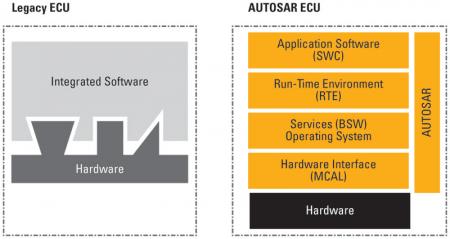
Benefits of migrating to AUTOSAR architecture:
- Improved reuse of ECUs in new car platforms and architectures
- Improved use of pre-validated and tested software components (representing vehicle functions)
- Reduced testing and safety certification costs
- Reduction in downstream design errors—an AUTOSAR methodology allows functions to be defined and verified at an architectural level
- Reduction in overall hardware cost by improved AUTOSAR network management and capacity utilization
- Reduced costs in overall network architecture analysis and design reviews
- Improved communication between OEMs and Tier 1 suppliers, by using a standardized digital exchange format (AUTOSAR XML or arxml)
(Source – RTC Magazine)
Which tools are used for AUTOSAR software development and AUTOSAR 4.3 Migration? What are their roles?
A number of AUTOSAR tools are deployed to develop an AUTOSAR compliant software. These tools are also very important for projects involving migration to AUTOSAR 4.3 or other versions.
Here is a list of tools that our AUTOSAR software developers are expert in:
- COMASSO: COMASSO is a registered association that supports implementation of the AUTOSAR Architecture as per the common global standard. (Source- https://www.comasso.org/).COMASSO provides a technical platform to the AUTOSAR software developers in order to reduce the integration efforts in software exchange or re-use.COMASSO as a platform facilitates AUTOSAR developers to maintain and develop AUTOSAR BSW as part of a community, which is similar to an Open Source community.COMASSO technical platform also helps the developers exchange source code, information and experience to implement AUTOSAR BSW.
- KPIT K-SAR AUTOSAR Suite: It is used by AUTOSAR Software developers to configure and generate AUTOSAR BSW (Base Software) and AUTOSAR RTE (Run-time Environment).The tool comprises of basic AUTOSAR Software Stack and K-SAR Editor.
- DaVinci Developer Tool from Vector: It is a development tool for designing the architecture of software components, that need to be deployed in AUTOSAR based Electronic Control Systems.It is used in application development phase of AUTOSAR software development projects.One of the tool’s biggest advantage is its ability to link model based development (MBD) tools via ARXML (a file format introduced by AUTOSAR to contain data used in Electronic Control Unit(ECU) development as per the AUTOSAR Architecture)
(Source – RTC Magazine)
